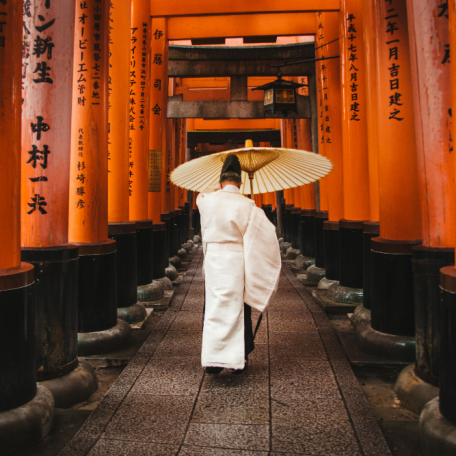SHINMAI: IT’S TIME TO SAVOR NEWLY HARVESTED RICE
Nov 26, 2023
BY Chisato Takahashi

In Japan, every autumn, “Shinmai” (newly harvested rice) is sold, making it the season when rice is the most delicious and popular. However, do you know when exactly rice can be called Shinmai?
In this blog, I will introduce the definition of new rice, its harvest period, how long it is available in stores, and tips on how to choose it.

Shinmai package. Photo Credit: もっと素材太郎
What is Shinmai?
In order to decide what Shinmai is, there are two concepts in Japan.
One of the concepts is “Rice Year”, which represents the designated year for rice transactions in Japan. In this context, Shinmai refers to rice harvested during the period from November 1st of the previous year to October 31st of the current year. However, due to climate change, the harvest period has been shifting, and these changes complicate the definition of new rice.
On the other hand, according to the JAS (Japanese Agricultural Standards) law, rice labeled as “新米” (Shinmai) must be packed by December 31 of the harvest year. If it is packaged after January, it cannot be labeled as newly harvested rice.

Harvesting Rice. Photo Credit: 半ライス大盛り^^
As I mentioned earlier, the timing of new rice appearing in stores varies depending on the climate in each region. Here is an example:
June: Okinawa
July: Okinawa and some parts of Kyushu
August: Kyushu to Kinki, Tokai, Hokuriku, Kanto
September: Kanto to Tohoku, Hokkaido
October: Tohoku, Hokkaido
Harvest times also depend on rice varieties, and some types might be available in stores starting from November. And rice that is packed at the end of the year tends to be sold around the beginning of the next year.
In addition, there are also new rice without the Shinmai label and old rice sold in supermarkets. Generally, rice that has been harvested for over a year is considered old rice. Therefore, when buying rice, it’s more accurate to check the “production year” and “milling date” on the package, regardless of whether it’s labeled as Shinmai or not.
The differences between new rice and old rice are clear. New rice is characterized by its sweetness, shine, firmness, stickiness, and higher moisture content. In fact, freshly harvested new rice is the most tasty to enjoy.

The best way to keep rice fresh. Photo Credit: Green planet
The Best Way to Keep Shinmai Fresh
The recommended period for enjoying freshly milled rice is approximately two weeks during the summertime from July to September and about one month from October to March during the winter. To fully savor the flavor, it’s essential to eat it as soon as possible rather than stockpiling it, even if it might seem inconvenient to buy it frequently. Additionally, proper storage makes new rice more delicious.
For instance, after milling, rice can lose flavor as its surface fats oxidize over time. Therefore, even if it’s impossible to use all at once, placing the rice in a plastic bottle, except for the portion to be used immediately, and keeping it in a refrigerator at 15 degrees Celsius or below can only prevent oxidation and pests.

Rinsing Rice. Photo Credit: MiLIFE
The Best Way to Cook
Freshly cooked Shinmai is the best!!!
Let me share some key points on how to cook new rice. The basic cooking steps remain the same, but the important thing is the water quantity.
Here are the steps:
- Measurement: Start by measuring the rice accurately.
- Rinsing: Quickly pour out the first water and rinse the rice gently. Since new rice grains are soft, please avoid washing too much. Rinse gently 3-4 times in a short period.
- Soaking: Let the rinsed new rice soak for about 15 minutes and then drain excess water. Since new rice contains more moisture, it is better to soak it for a shorter time compared to old rice. For regular rice, soak for 30 minutes (or 1 hour in winter).
- Water Amount: Typically, we use 1.2 times the amount of water compared to the rice. However, new rice gets water quickly inside and has softer fibers. Therefore, for 180 ml of Shinmai, reduce the water by about 10 ml. Water quantity may vary based on the harvest year, variety, and cooking method, so adjust based on your preference.
- Cooking: Cook new rice at a higher heat and for a shorter duration than usual. Bring it to a boil, then open the lid to stir with a spatula. Put the lid on AGAIN, reduce heat to its lowest, and let it cook for 15 minutes. Finally, turn off the heat afterward.
- Steaming: DO NOT OPEN THE LID YET. Keep the rice covered for a short steaming time, around 10 minutes.
- Fluffing: To release excess moisture, gently turn the rice from the bottom. Newly cooked rice is fluffy and tender, so be cautious not to stir too much, as it can become sticky if over-mixed.

Cooked Rice. Photo Credit: ACワークス株式会社
In this blog, I introduced newly harvested rice, known as “Shinmai.” It is sold until the end of the year and has distinct flavors, aromas, and stickiness compared to regular rice. While it stops being called Shinmai after the New Year, the important thing is when it is harvested and milled. Are you ready to cook Shinmai and savor the real Japanese rice flavor now? I hope my blog provided you with tips on selecting, storing, and preparing Shinmai to embrace the freshness, aroma, and distinctiveness of new rice in every delightful grain.
Featured image by CORO-photo
Discover hidden places while eating delicious foods in Japan with a local guide!
PIN THIS FOR LATER
Book your pocket wifi now to stay connected through your entire Japan Journey!

Be sure to get the JR Pass to make navigating Japan during your trip that much easier!

YOU MIGHT ALSO LIKE





